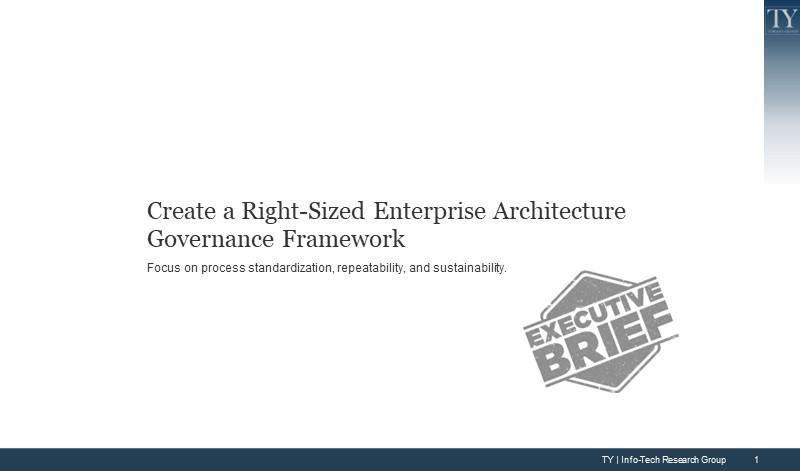
Create a Right-Sized Enterprise Architecture Governance Framework
- EA governance is perceived as an unnecessary layer of bureaucracy because business benefits are poorly communicated.
- The organization doesn’t have a formalized EA practice.
- Where an EA practice exists, employees are unsure of EA’s roles and responsibilities.
Our Advice
Critical Insight
- Enterprise architecture is not a technical function – it should be business-value driven and forward looking, positioning organizational assets in favor of long-term strategy rather than short-term tactics.
Impact and Result
- Value-focused. Focus EA governance on helping the organization achieve business benefits. Promote EA’s contribution in realizing business value.
- Right-sized. Re-use existing process checkpoints rather than creating new ones. Clearly define EA governance inclusion criteria for projects.
- Defined and measured process. Define metrics to measure EA’s performance and integrate EA governance with other governance processes such as project governance. Also clearly define the EA governing bodies’ composition, domain, inputs, and outputs.
- Strike the right balance. Adopt architecture principles that strikes the right balance between business and technology.
Create a Right-Sized Enterprise Architecture Governance Framework Research & Tools
Start here – read the Executive Brief
Read our Executive Brief to find out how implementing a successful enterprise architecture governance framework can benefit your organization.Besides the small introduction, subscribers and consulting clients within this management domain have access to:
- Create a Right-Sized Enterprise Architecture Governance Framework – Phases 1-7
1. Current State of EA Governance
Identify the organization’s standing in terms of the enterprise architecture practice, and know the gaps and what the EA practice needs to fulfill to create a good governance framework.
- Create a Right-Sized Enterprise Architecture Governance Framework – Phase 1: Current State of EA Governance
- EA Capability – Risk and Complexity Assessment Tool
- EA Governance Assessment Tool
2. EA Fundamentals
Understand the EA fundamentals and then refresh them to better align the EA practice with the organization and create business benefit.
- Create a Right-Sized Enterprise Architecture Governance Framework – Phase 2: EA Fundamentals
- EA Vision and Mission Template
- EA Goals and Measures Template
- EA Principles Template
3. Engagement Model
Analyze the IT operating model and identify EA’s role at each stage; refine it to promote effective EA engagement upfront in the early stages of the IT operating model.
- Create a Right-Sized Enterprise Architecture Governance Framework – Phase 3: Engagement Model
- EA Engagement Model Template
4. EA Governing Bodies
Set up EA governing bodies to provide guidance and foster a collaborative environment by identifying the correct number of EA governing bodies, defining the game plan to initialize the governing bodies, and creating an architecture review process.
- Create a Right-Sized Enterprise Architecture Governance Framework – Phase 4: EA Governing Bodies
- Architecture Board Charter Template
- Architecture Review Process Template
5. EA Policy
Create an EA policy to provide a set of guidelines designed to direct and constrain the architecture actions of the organization in the pursuit of its goals in order to improve architecture compliance and drive business value.
- Create a Right-Sized Enterprise Architecture Governance Framework – Phase 5: EA Policy
- EA Policy Template
- EA Assessment Checklist Template
- EA Compliance Waiver Process Template
- EA Compliance Waiver Form Template
6. Architectural Standards
Define architecture standards to facilitate information exchange, improve collaboration, and provide stability. Develop a process to update the architectural standards to ensure relevancy and promote process transparency.
- Create a Right-Sized Enterprise Architecture Governance Framework – Phase 6: Architectural Standards
- Architecture Standards Update Process Template
7. Communication Plan
Craft a plan to engage the relevant stakeholders, ascertain the benefits of the initiative, and identify the various communication methods in order to maximize the chances of success.
- Create a Right-Sized Enterprise Architecture Governance Framework – Phase 7: Communication Plan
- EA Governance Communication Plan Template
- EA Governance Framework Template
Workshop: Create a Right-Sized Enterprise Architecture Governance Framework
Workshops offer an easy way to accelerate your project. If you are unable to do the project yourself, and a Guided Implementation isn't enough, we offer low-cost delivery of our project workshops. We take you through every phase of your project and ensure that you have a roadmap in place to complete your project successfully.
1 Current State of EA governance (Pre-workshop)
The Purpose
Conduct stakeholder interviews to understand current state of EA practice and prioritize gaps for EA governance based on organizational complexity.
Key Benefits Achieved
Prioritized list of actions to arrive at the target state based on the complexity of the organization
Activities
1.1 Determine organizational complexity.
1.2 Conduct an assessment of the EA governance components.
1.3 Identify and prioritize gaps.
1.4 Conduct senior management interviews.
Outputs
Organizational complexity score
EA governance current state and prioritized list of EA governance component gaps
Stakeholder perception of the EA practice
2 EA Fundamentals and Engagement Model
The Purpose
Refine EA fundamentals to align the EA practice with the organization and identify EA touchpoints to provide guidance for projects.
Key Benefits Achieved
Alignment of EA goals and objectives with the goals and objectives of the organization
Early involvement of EA in the IT operating model
Activities
2.1 Review the output of the organizational complexity and EA assessment tools.
2.2 Craft the EA vision and mission.
2.3 Develop the EA principles.
2.4 Identify the EA goals.
2.5 Identify EA engagement touchpoints within the IT operating model.
Outputs
EA vision and mission statement
EA principles
EA goals and measures
Identified EA engagement touchpoints and EA level of involvement
3 EA Governing Bodies
The Purpose
Set up EA governing bodies to provide guidance and foster a collaborative environment by identifying the correct number of EA governing bodies, defining the game plan to initialize the governing bodies and creating an architecture review process.
Key Benefits Achieved
Business benefits are maximized and solution design is within the options set forth by the architectural reference models while no additional layers of bureaucracy are introduced
Activities
3.1 Identify the number of governing bodies.
3.2 Define the game plan to initialize the governing bodies.
3.3 Define the architecture review process.
Outputs
Architecture board structure and coverage
Identified architecture review template
4 EA Policy
The Purpose
Create an EA policy to provide a set of guidelines designed to direct and constrain the architecture actions of the organization in the pursuit of its goals in order to improve architecture compliance and drive business value.
Key Benefits Achieved
Improved architecture compliance, which ties investments to business value and provides guidance to architecture practitioners
Activities
4.1 Define the scope.
4.2 Identify the target audience.
4.3 Determine the inclusion and exclusion criteria.
4.4 Craft an assessment checklist.
Outputs
Defined scope
Inclusion and exclusion criteria for project review
Architecture assessment checklist
5 Architectural Standards and Communication Plan
The Purpose
Define architecture standards to facilitate information exchange, improve collaboration, and provide stability.
Craft a communication plan to implement the new EA governance framework in order to maximize the chances of success.
Key Benefits Achieved
Consistent development of architecture, increased information exchange between stakeholders
Improved process transparency
Improved stakeholder engagement
Activities
5.1 Identify and standardize EA work products.
5.2 Classifying the architectural standards.
5.3 Identifying the custodian of standards.
5.4 Update the standards.
5.5 List the changes identified in the EA governance initiative
5.6 Create a communication plan.
Outputs
Identified set of EA work products to standardize
Architecture information taxonomy
Identified set of custodian of standards
Standard update process
List of EA governance initiatives
Communication plan for EA governance initiatives
Further reading
Create a Right-Sized Enterprise Architecture Governance Framework
Focus on process standardization, repeatability, and sustainability.
ANALYST PERSPECTIVE
"Enterprise architecture is not a technology concept, rather it is the foundation on which businesses orient themselves to create and capture value in the marketplace. Designing architecture is not a simple task and creating organizations for the future requires forward thinking and rigorous planning.
Architecture processes that are supposed to help facilitate discussions and drive option analysis are often seen as an unnecessary overhead. The negative perception is due to enterprise architecture groups being overly prescriptive rather than providing a set of options that guide and constrain solutions at the same time.
EA groups should do away with the direct and control mindset and change to a collaborate and mentor mindset. As part of the architecture governance, EA teams should provide an option set that constrains design choices, and also be open to changes to standards or best practices. "
Gopi Bheemavarapu, Sr. Manager, CIO Advisory Info-Tech Research Group
Our understanding of the problem
This Research Is Designed For:
- CIO
- IT Leaders
- Business Leaders
- Head of Enterprise Architecture
- Enterprise Architects
- Domain Architects
- Solution Architects
This Research Will Help You:
- Understand the importance of enterprise architecture (EA) governance and how to apply it to guide architectural decisions.
- Enhance your understanding of the organization’s current EA governance and identify areas for improvement.
- Optimize your EA engagement model to maximize value creation.
- Learn how to set up the optimal number of governance bodies in order to avoid bureaucratizing the organization.
This Research Will Also Assist:
- Business Relationship Managers
- Business Analysts
- IT Managers
- Project Managers
- IT Analysts
- Quality Assurance Leads
- Software Developers
This Research Will Help Them:
- Give an overview of enterprise architecture governance
- Clarity on the role of enterprise architecture team
Executive summary
Situation
- Deployed solutions do not meet business objectives resulting in expensive and extensive rework.
- Each department acts independently without any regular EA touchpoints.
- Organizations practice project-level architecture as opposed to enterprise architecture.
Complication
- EA governance is perceived as an unnecessary layer of bureaucracy because business benefits are poorly communicated.
- The organization doesn’t have a formalized EA practice.
- Where an EA practice exists, employees are unsure of EA’s roles and responsibilities.
Resolution
- Value-focused. Focus EA governance on helping the organization achieve business benefits. Promote EA’s contribution in realizing business value.
- Right-sized. Re-use existing process checkpoints, rather than creating new ones. Clearly define EA governance inclusion criteria for projects.
- Defined and measured process. Define metrics to measure EA’s performance and integrate EA governance with other governance processes such as project governance. Also clearly define the EA governing bodies’ composition, domain, inputs, and outputs.
- Strike the right balance. Adopt architecture principles that strikes the right balance between business and technology imperatives.
Info-Tech Insight
Enterprise architecture is critical to ensuring that an organization has the solid IT foundation it needs to efficiently enable the achievement of its current and future strategic goals rather than focusing on short-term tactical gains.
What is enterprise architecture governance?
An architecture governance process is the set of activities an organization executes to ensure that decisions are made and accountability is enforced during the execution of its architecture strategy. (Hopkins, “The Essential EA Toolkit.”)
EA governance includes the following:
- Implement a system of controls over the creation and monitoring of all architectural components.
- Ensure effective introduction, implementation, and evolution of architectures within the organization.
- Implement a system to ensure compliance with internal and external standards and regulatory obligations.
- Develop practices that ensure accountability to a clearly identified stakeholder community, both inside and outside the organization.
(TOGAF)
IT governance sets direction through prioritization and decision making, and monitors overall IT performance.
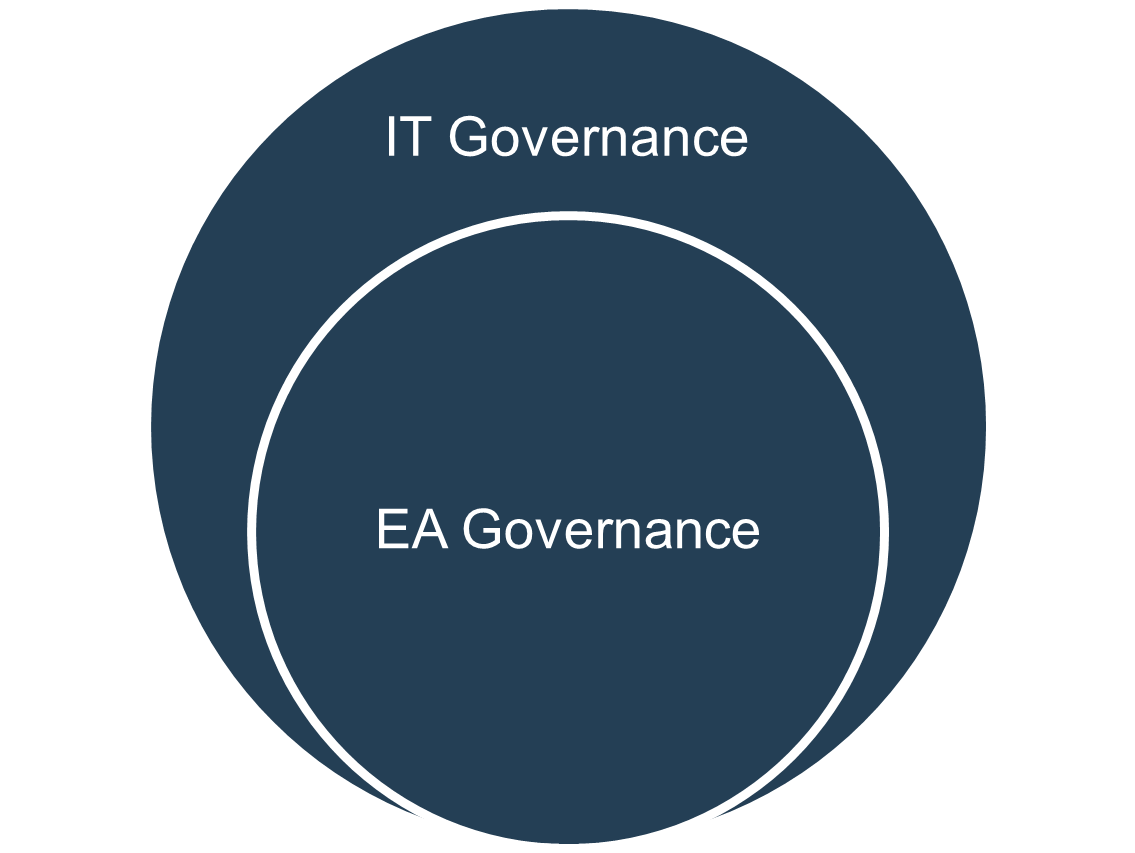
EA governance ensures that optimal architectural design choices are being made that focus on long-term value creation.
Harness the benefits of an optimized EA governance
Core benefits of EA governance are seen through:
Value creation
Effective EA governance ensures alignment between organizational investments and corporate strategic goals and objectives.
Cost reduction
Architecture standards provide guidance to identify opportunities for reuse and eliminate redundancies in an organization.
Risk optimization
Architecture review processes and assessment checklists ensure that solutions are within the acceptable risk levels of the organization.
EA governance is difficult to structure appropriately, but having an effective structure will allow you to:
- Achieve business strategy through faster time-to-market innovations and capabilities.
- Reduced transaction costs with more consistent business processes and information across business units.
- Lower IT costs due to better traceability, faster design, and lower risk.
- Link IT investments to organizational strategies and objectives
- Integrate and institutionalizes IT best practices.
- Enable the organization to take full advantage of its information, infrastructure, and hardware and software assets.
- Support regulatory as well as best practice requirements such as auditability, security, responsibility, and accountability.
Organizations that have implemented EA governance realize greater benefits from their EA programs
Modern day CIOs of high-performing organizations use EA as a strategic planning discipline to improve business-IT alignment, enable innovation, and link business and IT strategies to execution.
Recent Info-Tech research found that organizations that establish EA governance realize greater benefits from their EA initiatives.
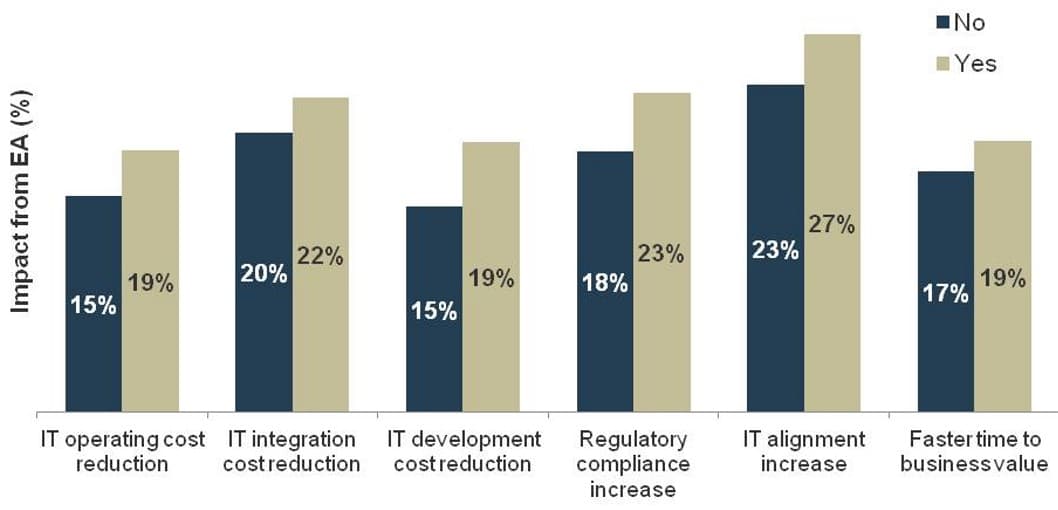
(Info-Tech Research Group, N=89)
Measure EA governance implementation effectiveness
Define key operational measures for internal use by IT and EA practitioners. Also, define business value measures that communicate and demonstrate the value of EA as an “enabler” of business outcomes to senior executives.
| EA performance measures (lead, operational) | EA value measures (lag) | |
|---|---|---|
| Application of EA management process | EA’s contribution to IT performance | EA’s contribution to business value |
Enterprise Architecture Management
- Number of months since the last review of target state EA blueprints.
IT Investment Portfolio Management
- Percentage of projects that were identified and proposed by EA.
Solution Development
- Number of projects that passed EA reviews.
- Number of building blocks reused.
Operations Management
- Reduction in the number of applications with overlapping functionality.
Business Value
- Lower non-discretionary IT spend.
- Decreased time to production.
- Higher satisfaction of IT-enabled services.
An insurance provider adopts a value-focused, right-sized EA governance program
CASE STUDY
Industry Insurance
Source Info-Tech
Situation
The insurance sector has been undergoing major changes, and as a reaction, businesses within the sector have been embracing technology to provide innovative solutions.
The head of EA in a major insurance provider (henceforth to be referred to as “INSPRO01”) was given the mandate to ensure that solutions are architected right the first time to maximize reuse and reduce technology debt. The EA group was at a critical point – to demonstrate business value or become irrelevant.
Complication
The project management office had been accountable for solution architecture and had placed emphasis on short-term project cost savings at the expense of long term durability.
There was a lack of awareness of the Enterprise Architecture group within INSPRO01, and people misunderstood the roles and responsibilities of the EA team.
Result
Info-Tech helped define the responsibilities of the EA team and clarify the differences between the role of a Solution Architect vs. Enterprise Architect.
The EA team was able to make the case for change in the project management practices to ensure architectures are reviewed and approved prior to implementation.
As a result, INSPRO01 saw substantial increases in reuse opportunities and thereby derived more value from its technology investments.
Success factors for EA governance
The success of any EA governance initiative revolves around adopting best practices, setting up repeatable processes, and establishing appropriate controls.
- Develop best practices for managing architecture policies, procedures, roles, skills, and organizational structures.
- Establish organizational responsibilities and structures to support the architecture governance processes.
- Management of criteria for the control of the architecture governance processes, dispensations, compliance assessments, and SLAs.
Info-Tech’s approach to EA governance
Our best-practice approach is grounded in TOGAF and enhanced by the insights and guidance from our analysts, industry experts, and our clients.
Value-focused. Focus EA governance on helping the organization achieve business benefits. Promote EA’s contribution in realizing business value.
Right-sized. Insert EA governance into existing process checkpoints rather than creating new ones. Clearly define EA governance inclusion criteria for projects.
Measured. Define metrics to measure EA’s performance, and integrate EA governance with other governance processes such as project governance. Also clearly define the EA governing bodies’ composition, domain, inputs, and outputs.
Balanced. Adopt architecture principles that strikes the right balance between business and technology.
Info-Tech’s EA governance framework
Info-Tech’s architectural governance framework provides a value-focused, right-sized approach with a strong emphasis on process standardization, repeatability, and sustainability.
- Current state of EA governance
- EA fundamentals
- Engagement model
- EA governing bodies
- EA policy
- Architectural standards
- Communication Plan
Use Info-Tech’s templates to complete this project
- Current state of EA governance
- EA Capability - Risk and Complexity Assessment Tool
- EA Governance Assessment Tool
- EA fundamentals
- EA Vision and Mission Template
- EA Goals and Measures Template
- EA Principles Template
- Engagement model
- EA Engagement Model Template
- EA governing bodies
- Architecture Board Charter Template
- Architecture Review Process Template
- EA policy
- EA Policy Template
- Architecture Assessment Checklist Template
- Compliance Waiver Process Template
- Compliance Waiver Form Template
- Architectural standards
- Architecture Standards Update Process Template
- Communication Plan
- EA Governance Communication Plan Template
- EA Governance Framework Template
As you move through the project, capture your progress with a summary in the EA Governance Framework Template.
Download the EA Governance Framework Template document for use throughout this project.
Info-Tech offers various levels of support to best suit your needs
DIY Toolkit
“Our team has already made this critical project a priority, and we have the time and capability, but some guidance along the way would be helpful.”
Guided Implementation
“Our team knows that we need to fix a process, but we need assistance to determine where to focus. Some check-ins along the way would help keep us on track.”
Workshop
“We need to hit the ground running and get this project kicked off immediately. Our team has the ability to take this over once we get a framework and strategy in place.”
Consulting
“Our team does not have the time or the knowledge to take this project on. We need assistance through the entirety of this project.”
Diagnostics and consistent frameworks used throughout all four options
EA governance framework – phase-by-phase outline (1/2)
| Current state of EA governance | EA Fundamentals | Engagement Model | EA Governing Bodies | |
|---|---|---|---|---|
| Best-Practice Toolkit |
1.1 Determine organizational complexity 1.2 Conduct an assessment of the EA governance components 1.3 Identify and prioritize gaps |
2.1 Craft the EA vision and mission 2.2 Develop the EA principles 2.3 Identify the EA goals |
3.1 Build the case for EA engagement 3.2 Identify engagement touchpoints within the IT operating model |
4.1 Identify the number of governing bodies 4.2 Define the game plan to initialize the governing bodies 4.3 Define the architecture review process |
| Guided Implementations |
|
|
|
|
|
Phase 1 Results:
|
Phase 2 Results:
|
Phase 3 Results:
|
Phase 4 Results:
|
EA governance framework – phase-by-phase outline (2/2)
| EA Policy | Architectural Standards | Communication Plan | |
|---|---|---|---|
| Best-Practice Toolkit |
5.1 Define the scope of EA policy 5.2 Identify the target audience 5.3 Determine the inclusion and exclusion criteria 5.4 Craft an assessment checklist |
6.1 Identify and standardize EA work products 6.2 Classify the architectural standards 6.3 Identify the custodian of standards 6.4 Update the standards |
7.1 List the changes identified in the EA governance initiative 7.2 Identify stakeholders 7.3 Create a communication plan |
| Guided Implementations |
|
|
|
|
Phase 5 Results:
|
Phase 6 Results:
|
Phase 7 Results:
|
Workshop overview
Contact your account representative or email Workshops@InfoTech.com for more information.
| Pre-workshop | Workshop Day 1 | Workshop Day 2 | Workshop Day 3 | Workshop Day 4 | |
|---|---|---|---|---|---|
| Activities | Current state of EA governance | EA fundamentals and engagement model | EA governing bodies | EA policy | Architectural standards and communication plan |
1.1 Determine organizational complexity 1.2 Conduct an assessment of the EA governance components 1.3 Identify and prioritize gaps 1.4 Senior management interviews |
|
|
|
| |
| Deliverables |
|
|
|
|
|
Phase 1
Current State of EA Governance
Create a Right-Sized Enterprise Architecture Governance Framework
Current State of EA Governance
- Current State of EA Governance
- EA Fundamentals
- Engagement Model
- EA Governing Bodies
- EA Policy
- Architectural Standards
- Communication Plan
This phase will walk you through the following activities:
- Determine organizational complexity
- Conduct an assessment of the EA governance components
- Identify and prioritize gaps
This step involves the following participants:
- CIO
- IT Leaders
- Business Leaders
- Head of Enterprise Architecture
- Enterprise Architects
- Domain Architects
- Solution Architects
Outcomes of this step
- Prioritized list of gaps
Info-Tech Insight
Correlation is not causation – an apparent problem might be a symptom rather than a cause. Assess the organization’s current EA governance to discover the root cause and go beyond the symptoms.
Phase 1 guided implementation outline
Call 1-888-670-8889 or email GuidedImplementations@InfoTech.com for more information.Complete these steps on your own, or call us to complete a guided implementation. A guided implementation is a series of 2-3 advisory calls that help you execute each phase of a project. They are included in most advisory memberships.
Guided Implementation 1: Current State of EA Governance
Proposed Time to Completion: 2 weeks
Step 1.1: Determine organizational complexity
Start with an analyst kick-off call:
- Discuss how to use Info-Tech’s EA Capability – Risk and Complexity Assessment Tool.
- Discuss how to complete the inputs on the EA Governance Assessment Tool.
Then complete these activities…
- Conduct an assessment of your organization to determine its complexity.
- Assess the state of EA governance within your organization.
With these tools & templates:
- EA Capability – Risk and Complexity Assessment Tool
- EA Governance Assessment Tool
Step 1.2: Assess current state of EA governance
Start with an analyst kick-off call:
- Review the output of the EA governance assessment and gather feedback on your goals for the EA practice.
Then complete these activities…
- Discuss whether you are ready to proceed with the project.
- Review the list of tasks and plan your next steps.
With these tools & templates:
- EA Governance Assessment Tool
Right-size EA governance based on organizational complexity
Determining organizational complexity is not rocket science. Use Info-Tech’s tool to quantify the complexity and use it, along with common sense, to determine the appropriate level of architecture governance.
Info-Tech’s methodology uses six factors to determine the complexity of the organization:
- The size of the organization, which can often be denoted by the revenue, headcount, number of applications in use, and geographical diversity.
- The solution alignment factor helps indicate the degree to which various projects map to the organization’s strategy.
- The size and complexity of the IT infrastructure and networks.
- The portfolio of applications maintained by the IT organization.
- Key changes within the organization such as M&A, regulatory changes, or a change in business or technology leadership.
- Other negative influences that can adversely affect the organization.
Determine your organization’s level of complexity
1.1 2 hours
Input
- Group consensus on the current state of EA competencies.
Output
- A list of gaps that need to be addressed for EA governance competencies.
Materials
- Info-Tech’s EA assessment tool, a computer, and/or a whiteboard and marker.
Participants
- EA team, business line leads, IT department leads.
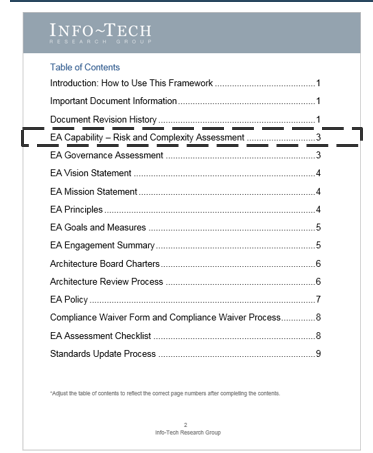
Step 1 - Facilitate
Download the EA Capability – Risk and Complexity Assessment Tool to facilitate a session on determining your organization’s complexity.
Download EA Organizational - Risk and Complexity Assessment Tool
Step 2 - Summarize
Summarize the results in the EA governance framework document.
Update the EA Governance Framework Template
Understand the components of effective EA governance
EA governance is multi-faceted and it facilitates effective use of resources to meet organizational strategic objectives through well-defined structural elements.
EA Governance
- Fundamentals
- Engagement Model
- Policy
- Governing Bodies
- Architectural Standards
Components of architecture governance
- EA vision, mission, goals, metrics, and principles that provide a direction for the EA practice.
- An engagement model showing where and in what fashion EA is engaged in the IT operating model.
- An architecture policy formulated and enforced by the architectural governing bodies to guide and constrain architectural choices in pursuit of strategic goals.
- Governing bodies to assess projects for compliance and provide feedback.
- Architectural standards that codify the EA work products to ensure consistent development of architecture.
Next Step: Based on the organization’s complexity, conduct a current state assessment of EA governance using Info-Tech’s EA Governance Assessment Tool.
Assess the components of EA governance in your organization
1.2 2 hrs
Input
- Group consensus on the current state of EA competencies.
Output
- A list of gaps that need to be addressed for EA governance competencies.
Materials
- Info-Tech’s EA assessment tool, a computer, and/or a whiteboard and marker.
Participants
- EA team, business line leads, IT department leads.
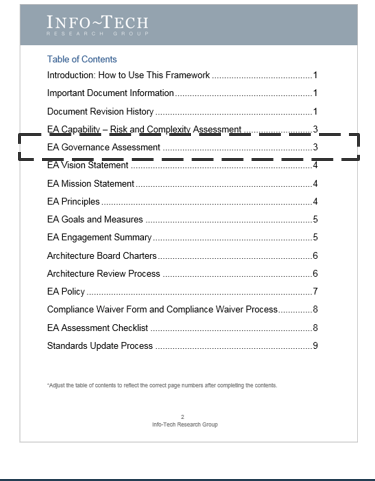
Step 1 - Facilitate
Download the “EA Governance Assessment Tool” to facilitate a session on identifying the best practices to be applied in your organization.
Download Info-Tech’s EA Governance Assessment Tool
Step 2 - Summarize
Summarize the identified best practices in the EA governance framework document.
Update the EA Governance Framework Template
Conduct a current state assessment to identify limitations of the existing EA governance framework
CASE STUDY
Industry Insurance
Source Info-Tech
Situation
INSPRO01 was planning a major transformation initiative. The organization determined that EA is a strategic function.
The CIO had pledged support to the EA group and had given them a mandate to deliver long-term strategic architecture.
The business leaders did not trust the EA team and believed that lack of business skills in the group put the business transformation at risk.
Complication
The EA group had been traditionally seen as a technology organization that helps with software design.
The EA team lacked understanding of the business and hence there had been no common language between business and technology.
Result
Info-Tech helped the EA team create a set of 10 architectural principles that are business-value driven rather than technical statements.
The team socialized the principles with the business and technology stakeholders and got their approvals.
By applying the business focused architectural principles, the EA team was able to connect with the business leaders and gain their support.
If you want additional support, have our analysts guide you through this phase as part of an Info-Tech workshop
Book a workshop with our Info-Tech analysts:
- To accelerate this project, engage your IT team in an Info-Tech workshop with an Info-Tech analyst team.
- Info-Tech analysts will join you and your team onsite at your location or welcome you to Info-Tech’s historic Toronto office to participate in an innovative onsite workshop.
- Contact your account manager (www.infotech.com/account), or email Workshops@InfoTech.com for more information.
The following are sample activities that will be conducted by Info-Tech analysts with your team:
Key Activities
- Determine organizational complexity.
- Conduct an assessment of the EA governance components.
- Identify and prioritize gaps.
Outcomes
- Organizational complexity assessment
- EA governance capability assessment
- A prioritized list of capability gaps
Phase 2
EA Fundamentals
Create a Right-Sized Enterprise Architecture Governance Framework
EA Fundamentals
- Current State of EA Governance
- EA Fundamentals
- Engagement Model
- EA Governing Bodies
- EA Policy
- Architectural Standards
- Communication Plan
This phase will walk you through the following activities:
- Craft the EA vision and mission
- Develop the EA principles.
- Identify the EA goals
This step involves the following participants:
- CIO
- IT Leaders
- Business Leaders
- Head of Enterprise Architecture
- Enterprise Architects
- Domain Architects
- Solution Architects
Outcomes of this step
- Refined set of EA fundamentals to support the building of EA governance
Info-Tech Insight
A house divided against itself cannot stand – ensure that the EA fundamentals are aligned with the organization’s goals and objectives.
Phase 2 guided implementation outline
Call 1-888-670-8889 or email GuidedImplementations@InfoTech.com for more information.
Complete these steps on your own, or call us to complete a guided implementation. A guided implementation is a series of 2-3 advisory calls that help you execute each phase of a project. They are included in most advisory memberships.
Guided Implementation 2: EA Fundamentals
Proposed Time to Completion: 3 weeks
Step 2.1: Develop the EA fundamentals
Review findings with analyst:
- Discuss the importance of the EA fundamentals – vision, mission, goals, measures, and principles.
- Understand how to align the EA vision, mission, goals, and measures to your organization’s vision, mission, goals, measures, and principles.
Then complete these activities…
- Develop the EA vision statements.
- Craft the EA mission statements.
- Define EA goals and measures.
- Adopt EA principles.
With these tools & templates:
- EA Vision and Mission Template
- EA Principles Template
- EA Goals and Measures Template
Step 2.2: Review the EA fundamentals
Review findings with analyst:
- Review the EA fundamentals in conjunction with the results of the EA governance assessment tool and gather feedback.
Then complete these activities…
- Refine the EA vision, mission, goals, measures, and principles.
- Review the list of tasks and plan your next steps.
With these tools & templates:
- EA Vision and Mission Template
- EA Principles Template
- EA Goals and Measures Template
Fundamentals of an EA organization
Vision, mission, goals and measures, and principles form the foundation of the EA function.
Factors to consider when developing the vision and mission statements
The vision and mission statements provide strategic direction to the EA team. These statements should be created based on the business and technology drivers in the organization.
Business Drivers
- Business drivers are factors that determine, or cause, an increase in value or major improvement of a business.
- Examples of business drivers include:
- Increased revenue
- Customer retention
- Salesforce effectiveness
- Innovation
Technology Drivers
- Technology drivers are factors that are vital for the continued success and growth of a business using effective technologies.
- Examples of technology drivers include:
- Enterprise integration
- Information security
- Portability
- Interoperability
"The very essence of leadership is [that] you have a vision. It's got to be a vision you articulate clearly and forcefully on every occasion. You can't blow an uncertain trumpet." – Theodore Hesburgh
Develop vision, mission, goals, measures, and principles to define the EA capability direction and purpose
EA capability vision statement
Articulates the desired future state of EA capability expressed in the present tense.
- What will be the role of EA capability?
- How will EA capability be perceived?
Example: To be recognized by both the business and IT as a trusted partner that drives [Company Name]’s effectiveness, efficiency, and agility.
EA capability mission statement
Articulates the fundamental purpose of the EA capability.
- Why does EA capability exist?
- What does EA capability do to realize its vision?
- Who are the key customers of the EA capability?
Example: Define target enterprise architecture for [Company Name], identify solution opportunities, inform IT investment management, and direct solution development, acquisition, and operation compliance.
EA capability goals and measures
EA capability goals define specific desired outcomes of an EA management process execution. EA capability measures define how to validate the achievement of the EA capability goals.
Example:
Goal: Improve reuse of IT assets at [Company Name].
Measures:
- The number of building blocks available for reuse.
- Percent of projects that utilized existing building blocks.
- Estimated efficiency gain (= effort to create a building block * reuse count).
EA principles
EA principles are shared, long-lasting beliefs that guide the use of IT in constructing, transforming, and operating the enterprise by informing and restricting target-state enterprise architecture design, solution development, and procurement decisions.
Example:
- EA principle name: Reuse.
- Statement: Maximize reuse of existing assets.
- Rationale: Reuse prevents duplication of development and support efforts, increasing efficiency, and agility.
- Implications: Define architecture and solution building blocks and ensure their consistent application.
EA principles guide decision making
Policies can be seen as “the letter of the law,” whereas EA principles summarize “the spirit of the law.”
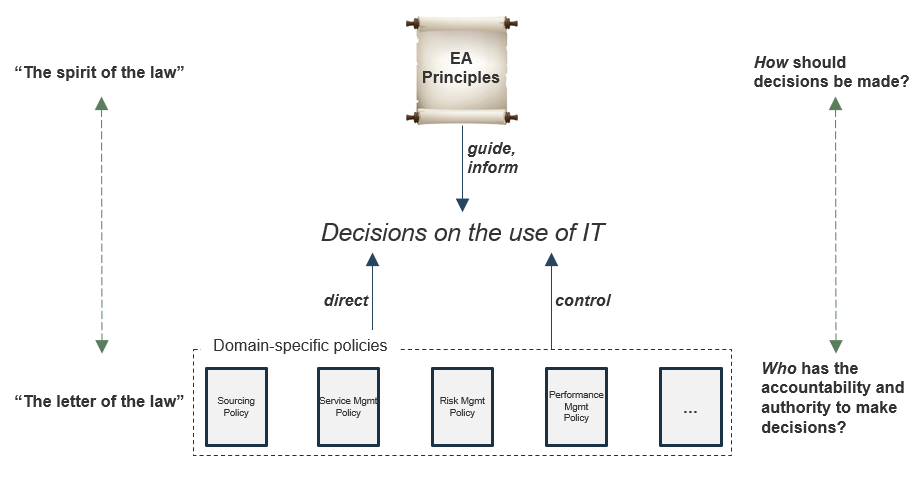
Define EA capability goals and related measures that resonate with EA capability stakeholders
EA capability goals, i.e. specific desired outcomes of an EA management process execution. Use COBIT 5, APO03 process goals, and metrics as a starting point.
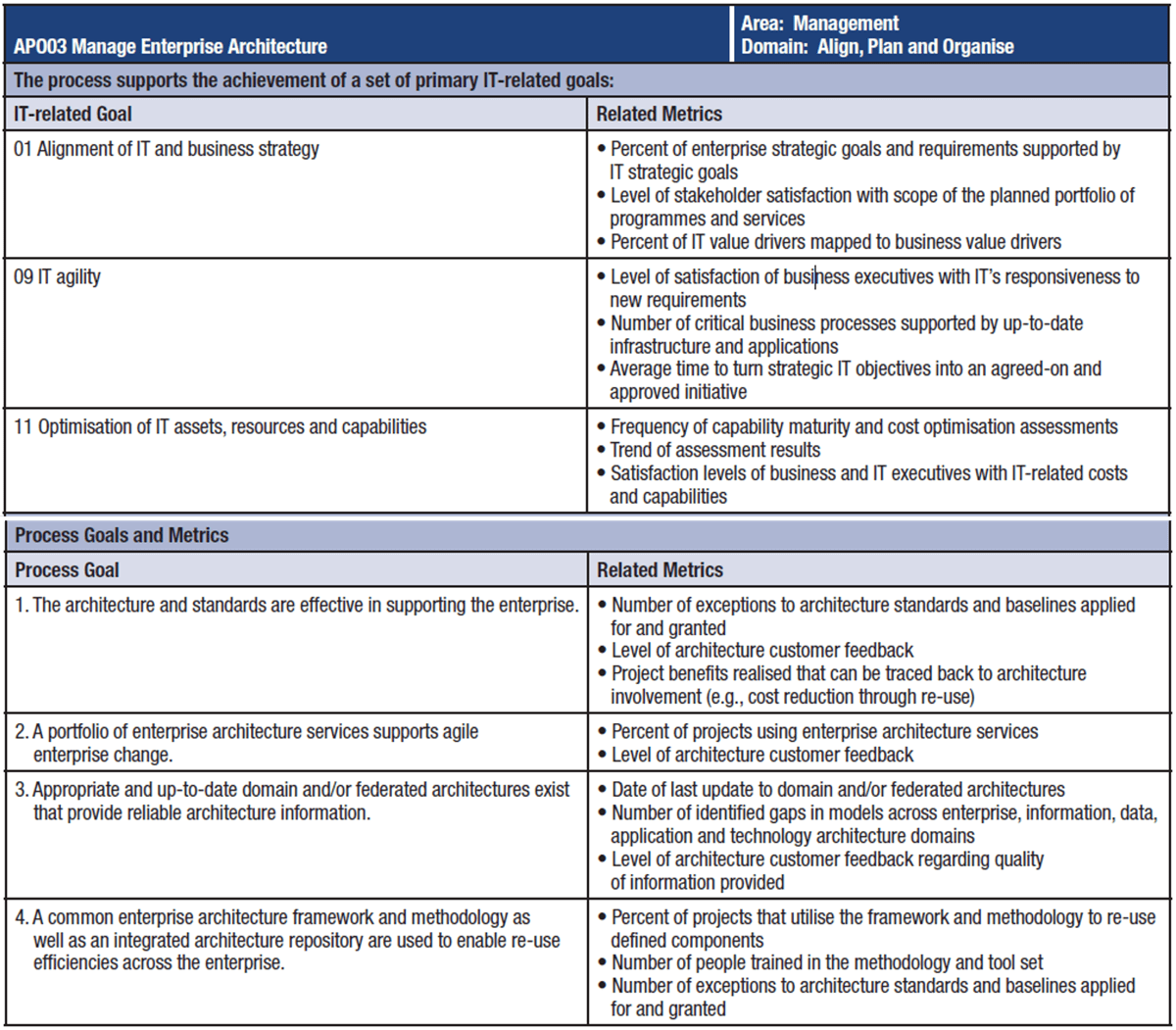
Define relevant business value measures to collect indirect evidence of EA’s contribution to business benefits
Define key operational measures for internal use by IT and EA practitioners. Also, define business value measures that communicate and demonstrate the value of EA as an enabler of business outcomes to senior executives.
| EA performance measures (lead, operational) | EA value measures (lag) | |
|---|---|---|
| Application of EA management process | EA’s contribution to IT performance | EA’s contribution to business value |
Enterprise Architecture Management
- Number of months since the last review of target state EA blueprints.
IT Investment Portfolio Management
- Percentage of projects that were identified and proposed by EA.
Solution Development
- Number of projects that passed EA reviews.
- Number of building blocks reused.
Operations Management
- Reduction in the number of applications with overlapping functionality.
Business Value
- Lower non-discretionary IT spend.
- Decreased time to production.
- Higher satisfaction of IT-enabled services.
Refine the organization’s EA fundamentals
2.1 2 hrs
Input
- Group consensus on the current state of EA competencies.
Output
- A list of gaps that need to be addressed for EA governance competencies.
Materials
- Info-Tech’s EA assessment tool, a computer, and/or a whiteboard and marker.
Participants
- EA team, business line leads, IT department leads.
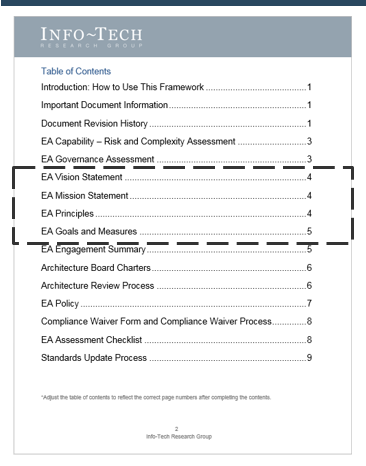
Step 1 - Facilitate
Download the three templates and hold a working session to facilitate a session on creating EA fundamentals.
Download the EA Vision and Mission Template, the EA Principles Template, and the EA Goals and Measures Template
Step 2 - Summarize
Document the final vision, mission, principles, goals, and measures within the EA Governance Framework.
Update the EA Governance Framework Template
Ensure that the EA fundamentals are aligned to the organizational needs
CASE STUDY
Industry Insurance
Source Info-Tech
Situation
The EA group at INSPRO01 was being pulled in multiple directions with requests ranging from architecture review to solution design to code reviews.
Project level architecture was being practiced with no clarity on the end goal. This led to EA being viewed as just another IT function without any added benefits.
Info-Tech recommended that the EA team ensure that the fundamentals (vision, mission, principles, goals, and measures) reflect what the team aspired to achieve before fixing any of the process concerns.
Complication
The EA team was mostly comprised of technical people and hence the best practices outlined were not driven by business value.
The team had no documented vision and mission statements in place. In addition, the existing goals and measures were not tied to the business strategic objectives.
The team had architectural principles documented, but there were too many and they were very technical in nature.
Result
With Info-Tech’s guidance, the team developed a vision and mission statement to succinctly communicate the purpose of the EA function.
The team also reduced and simplified the EA principles to make sure they were value driven and communicated in business terms.
Finally, the team proposed goals and measures to track the performance of the EA team.
With the fundamentals in place, the team was able to show the value of EA and gain organization-wide acceptance.
If you want additional support, have our analysts guide you through this phase as part of an Info-Tech workshop
Book a workshop with our Info-Tech analysts:
- To accelerate this project, engage your IT team in an Info-Tech workshop with an Info-Tech analyst team.
- Info-Tech analysts will join you and your team onsite at your location or welcome you to Info-Tech’s historic Toronto office to participate in an innovative onsite workshop.
- Contact your account manager (www.infotech.com/account), or email Workshops@InfoTech.com for more information.
The following are sample activities that will be conducted by Info-Tech analysts with your team:
Key Activities
- Craft the EA vision and mission.
- Develop the EA principles.
- Identify the EA goals.
Outcomes
- Refined set of EA fundamentals to support the building of EA governance.
Phase 3
Engagement Model
Create a Right-Sized Enterprise Architecture Governance Framework
Engagement Model
- Current state of EA governance
- EA fundamentals
- Engagement model
- EA governing bodies
- EA policy
- Architectural standards
- Communication Plan
This step will walk you through the following activities:
- Build the case for EA engagement
- Engagement touchpoints within the IT operating model
This step involves the following participants:
- CIO
- IT Leaders
- Business Leaders
- Head of Enterprise Architecture
- Enterprise Architects
- Domain Architects
- Solution Architects
Outcomes of this step
- Summary of the assessment of the current EA engagement model
- Target EA engagement model
Info-Tech Insight
Perform due diligence prior to decision making. Use the EA Engagement Model to promote conversations between stage gate meetings as opposed to having the conversation during the stage gate meetings.
Phase 3 guided implementation outline
Call 1-888-670-8889 or email GuidedImplementations@InfoTech.com for more information.
Complete these steps on your own, or call us to complete a guided implementation. A guided implementation is a series of 2-3 advisory calls that help you execute each phase of a project. They are included in most advisory memberships.
Guided Implementation 3: EA engagement model
Proposed Time to Completion: 2 weeks
Step 3.1 Review the current IT operating model
Start with an analyst kick-off call:
- Review Info-Tech’s IT operating model.
- Understand how to document your organization’s IT operating model.
- Document EA’s current role and responsibility at each stage of the IT operating model.
Then complete these activities…
- Document your organization’s IT operating model.
With these tools & templates:
- EA Engagement Model Template
Step 3.2: Determine the target engagement model
Review findings with analyst:
- Review your organization’s current state IT operating model.
- Review your EA’s role and responsibility at each stage of the IT operating model.
- Document the role and responsibility of EA in the future state.
Then complete these activities…
- Document EA’s future role within each stage of your organization’s IT operating model.
With these tools & templates:
- EA Engagement Model Template.
The three pillars of EA Engagement
Effective EA engagement revolves around three basic principles – generating business benefits, creating adaptable models, and being able to replicate the process across the organization.
Business Value Driven
Focus on generating business value from organizational investments.
Repeatable
Process should be standardized, transparent, and repeatable so that it can be consistently applied across the organization.
Flexible
Accommodate the varying needs of projects of different sizes.
Where these pillars meet: Advocates long-term strategic vs. short-term tactical solutions.
EA interaction points within the IT operating model
EA’s engagement in each stage within the plan, build, and run phases should be clearly defined and communicated.
| Plan | Strategy Development | Business Planning | Conceptualization | Portfolio Management |
|---|---|---|---|---|
| ↓ | ||||
| Build | Requirements | Solution Design | Application Development/ Procurement | Quality Assurance |
| ↓ | ||||
| Run | Deploy | Operate |
Document the organization’s current IT operating model
3.1 2-3 hr
Input
- IT project lifecycle
Output
- Organization’s current IT operating model.
Materials
- A computer, and/or a whiteboard and marker.
Participants
- EA team, IT department leads, business leaders.
Instructions:
Hold a working session with the participants to document the current IT operating model. Facilitate the activity using the following steps:
1. Map out the IT operating model.
- Find a project that was just deployed within the organization and backtrack every step of the way to the strategy development that resulted in the conception of the project.
- Interview the personnel involved with each step of the process to get a sense of whether or not projects usually move to deployment going through these steps.
- Review Info-Tech’s best-practice IT operating model presented in the EA Engagement Model Template, and add or remove any steps to the existing organization’s IT operating model as necessary. Document the finalized steps of the IT operating model.
2. Determine EA’s current role in the operating model.
- Interview EA personnel through each step of the process and ask them their role. This is to get a sense of the type of input that EA is having into each step of the process.
- Using the EA Engagement Model Template, document the current role of EA in each step of the organization’s IT operation as you complete the interviews.
Download the EA Engagement Model Template to document the organization’s current IT operating model.
Define RACI in every stage of the IT operating model (e.g. EA role in strategy development phase of the IT operating model is presented below)
Strategy Development
Also known as strategic planning, strategy development is fundamental to creating and running a business. It involves the creation of a longer-term game plan or vision that sets specific goals and objectives for a business.
| R | Those in charge of performing the task. These are the people actively involved in the completion of the required work. | → | Business VPs, EA, IT directors | R |
| A | The one ultimately answerable for the correct and thorough completion of the deliverable or task, and the one who delegates the work to those responsible. | → | CEO | A |
| C | Those whose opinions are sought before a decision is made, and with whom there is two-way communication. | → | PMO, Line managers, etc. | C |
| I | Those who are kept up to date on progress, and with whom there is one-way communication. | → | Development managers, etc. | I |
Next Step: Similarly define the RACI for each stage of the IT operating model; refer to the activity slide for prompts.
Best practices on the role of EA within the IT operating model
| Plan |
Strategy Development C |
Business Planning C |
Conceptualization A |
Portfolio Management C |
|---|---|---|---|---|
| Build |
Requirements C |
Solution Design R |
Application Development/ Procurement R |
Quality Assurance I |
| Run |
Deploy I |
Operate I |
Next Step: Define the role of EA in each stage of the IT operating model; refer to the activity slide for prompts.
Define EA’s target role in each step of the IT operating model
3.2 2 hrs
Input
- Organization’s IT operating model.
Output
- Organization’s EA engagement model.
Materials
- A computer, and/or a whiteboard and marker.
Participants
- EA team, CIO, business leaders, IT department leaders.
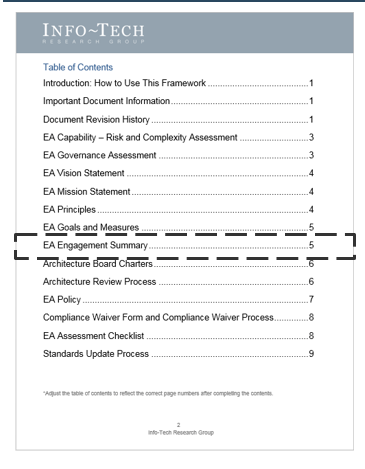
Step 1 - Facilitate
Download the EA Engagement Model Template and hold a working session to define EA’s target role in each step of the IT operating model.
Download the EA Engagement Model Template
Step 2 - Summarize
Document the target state role of EA within the EA Governance Framework document.
Update the EA Governance Framework Template
Design an EA engagement model to formalize EA’s role within the IT operating model
CASE STUDY
Industry Insurance
Source Info-Tech
Situation
INSPRO01 had a high IT cost structure with looming technology debt due to a preference for short-term tactical gains over long-term solutions.
The business satisfaction with IT was at an all-time low due to expensive solutions that did not meet business needs.
INSPRO01’s technology landscape was in disarray with many overlapping systems and interoperability issues.
Complication
No single team within the organization had an end-to-end perspective all the way from strategy to project execution. A lot of information was being lost in handoffs between different teams.
This led to inconsistent design/solution patterns being applied. Investment decisions had not been grounded in reality and this often led to cost overruns.
Result
Info-Tech helped INSPRO01 identify opportunities for EA team engagement at different stages of the IT operating model. EA’s role within each stage was clearly defined and documented.
With Info-Tech’s help, the EA team successfully made the case for engagement upfront during strategy development rather than during project execution.
The increased transparency enabled the EA team to ensure that investments were aligned to organizational strategic goals and objectives.
If you want additional support, have our analysts guide you through this phase as part of an Info-Tech workshop
Book a workshop with our Info-Tech analysts:
- To accelerate this project, engage your IT team in an Info-Tech workshop with an Info-Tech analyst team.
- Info-Tech analysts will join you and your team onsite at your location or welcome you to Info-Tech’s historic Toronto office to participate in an innovative onsite workshop.
- Contact your account manager (www.infotech.com/account), or email Workshops@InfoTech.com for more information.
The following are sample activities that will be conducted by Info-Tech analysts with your team:
Key Activities
- Build the case for EA engagement.
- Identify engagement touchpoints within the IT operating model.
Outcomes
- Summary of the assessment of the current EA engagement model
- Target EA engagement model
Phase 4
EA Governing Bodies
Create a Right-Sized Enterprise Architecture Governance Framework
EA Governing Bodies
- Current state of EA governance
- EA fundamentals
- Engagement model
- EA governing bodies
- EA policy
- Architectural standards
- Communication Plan
This phase will walk you through the following activities:
- Identify the number of governing bodies
- Define the game plan to initialize the governing bodies
- Define the architecture review process
This step involves the following participants:
- CIO
- IT Leaders
- Business Leaders
- Head of Enterprise Architecture
- Enterprise Architects
- Domain Architects
- Solution Architects
Outcomes of this step
- Charter definition for each EA governance board
Info-Tech Insight
Use architecture governance like a scalpel rather than a hatchet. Implement governing bodies to provide guidance rather than act as a police force.
Phase 4 guided implementation
Call 1-888-670-8889 or email GuidedImplementations@InfoTech.com for more information.
Complete these steps on your own, or call us to complete a guided implementation. A guided implementation is a series of 2-3 advisory calls that help you execute each phase of a project. They are included in most advisory memberships.
Guided Implementation 4: Create or identify EA governing bodies
Proposed Time to Completion: 2 weeks
Step 4.1: Identify architecture boards and develop charters
Start with an analyst kick-off call:
- Understand the factors influencing the number of governing bodies required for an organization.
- Understand the components of a governing body charter.
Then complete these activities…
- Identify how many governing bodies are needed.
- Define EA governing body composition, meeting frequency, and domain of coverage.
- Define the inputs and outputs of each EA governing body.
- Identify mandatory inclusion criteria.
With these tools & templates:
- Architecture Board Charter Template
Step 4.2: Develop an architecture review process
Follow-up with an analyst call:
- Review the number of boards identified for your organization and gather feedback.
- Review the charters developed for each governing body and gather feedback.
- Understand the various factors that impact the architecture review process.
- Review Info-Tech’s best-practice architecture review process.
Then complete these activities…
- Refine the charters for governing bodies.
- Develop the architecture review process for your organization.
With these tools & templates:
- Architecture Review Process Template
Factors that determine the number of architectural boards required
The primary purpose of architecture boards is to ensure that business benefits are maximized and solution design is within the options set forth by the architectural reference models without introducing additional layers of bureaucracy.
The optimal number of architecture boards required in an organization is a function of the following factors:
- EA organization model
- Distributed
- Federated
- Centralized
- Architecture domains Maturity of architecture domains
- Project throughput
Commonly observed architecture boards:
- Architecture Review Board
- Technical Architecture Committee
- Data Architecture Review Board
- Infrastructure Architecture Review Board
- Security Architecture Review Board
Info-Tech Insight
Before building out a new governance board, start small by repurposing existing forums by adding architecture as an agenda item. As the items for review increase consider introducing dedicated governing bodies.
EA organization model drives the architecture governance structure
EA teams can be organized in three ways – distributed, federated, and centralized. Each model has its own strengths and weaknesses. EA governance must be structured in a way such that the strengths are harvested and the weaknesses are mitigated.
| Distributed | Federated | Centralized | |
|---|---|---|---|
| EA org. structure |
|
|
|
| Implications |
|
|
|
| Architectural boards |
|
|
|
Architecture domains influences the number of architecture boards required
- An architecture review board (ARB) provides direction for domain-specific boards and acts as an escalation point. The ARB must have the right mix of both business and technology stakeholders.
- Domain-specific boards provide a platform to have focused discussions on items specific to that domain.
- Based on project throughput and the maturity of each domain, organizations would have to pick the optimal number of boards.
- Architecture working groups provide a platform for cross-domain conversations to establish organization wide standards.
| Level 1 | Architecture Review Board | IT and Business Leaders | ||||
| Level 2 | Business Architecture Board | Data Architecture Board | Application Architecture Board | Infrastructure Architecture Board | Security Architecture Board | IT and Business Managers |
| Level 3 | Architecture Working Groups | Architects | ||||
Create a game plan for the architecture boards
- Start with a single board for each level – an architecture review board (ARB), a technical architecture committee (TAC), and architecture working groups.
- As the organization matures and the number of requests to the TAC increase, consider creating domain-specific boards – such as business architecture, data architecture, application architecture, etc. – to handle architecture decisions pertaining to that domain.
Start with this:
| Level 1 | Architecture Review Board |
| Level 2 | Technical Architecture Committee |
| Level 3 | Architecture Working Groups |
Change to this:
| Architecture Review Board | IT and Business Leaders | ||||
| Business Architecture Board | Data Architecture Board | Application Architecture Board | Infrastructure Architecture Board | Security Architecture Board | IT and Business Managers |
| Architecture Working Groups | Architects | ||||
Architecture boards have different objectives and activities
The boards at each level should be set up with the correct agenda – ensure that the boards’ composition and activities reflect their objective. Use the entry criteria to communicate the agenda for their meetings.
| Architecture Review Board | Technical Architecture Committee | |
|---|---|---|
| Objective |
|
|
| Composition |
|
|
| Activities |
|
|
| Entry Criteria |
|
|
Identify the number of governing bodies
4.1 2 hrs
Input
- EA Vision and Mission
- EA Engagement Model
Output
- A list of EA governing bodies.
Materials
- A computer, and/or a whiteboard and marker.
Participants
- EA team, CIO, business line leads, IT department leads.
Instructions:
Hold a working session with the participants to identify the number of governing bodies. Facilitate the activity using the following steps:
- Examine the EA organization models mentioned previously. Assess how your organization is structured, and identify whether your organization has a federated, distributed or centralized EA organization model.
- Reference the “Game plan for the architecture boards” slide. Assess the architecture domains, and define how many there are in the organization.
- Architecture domains:
- If no defined architecture domains exist, model the number of governing bodies in the organization based on the “Start with this” scenario in the “Game plan for the architecture boards” slide.
- If defined architecture domains do exist, model the number of governing bodies based on the “Change to this” scenario in the “Game plan for the architecture boards” slide.
- Name each governing body you have defined in the previous step. Download Info-Tech’s Architecture Board Charter Template for each domain you have named. Input the names into the title of each downloaded template.
Download the Architecture Board Charter Template to document this activity.
Defining the governing body charter
The charter represents the agreement between the governing body and its stakeholders about the value proposition and obligations to the organization.
- Purpose: The reason for the existence of the governing body and its goals and objectives.
- Composition: The members who make up the committee and their roles and responsibilities in it.
- Frequency of meetings: The frequency at which the committee gathers to discuss items and make decisions.
- Entry/Exit Criteria: The criteria by which the committee selects items for review and items for which decisions can be taken.
- Inputs: Materials that are provided as inputs for review and decision making by the committee.
- Outputs: Materials that are provided by the committee after an item has been reviewed and the decision made.
- Activities: Actions undertaken by the committee to arrive at its decision.
Define EA’s target role in each step of the IT operating model
4.2 3 hrs
Input
- A list of all identified EA governing bodies.
Output
- Charters for each EA governing bodies.
Materials
- A computer, and/or a whiteboard and marker.
Participants
- EA team, business line leads, IT department leads.
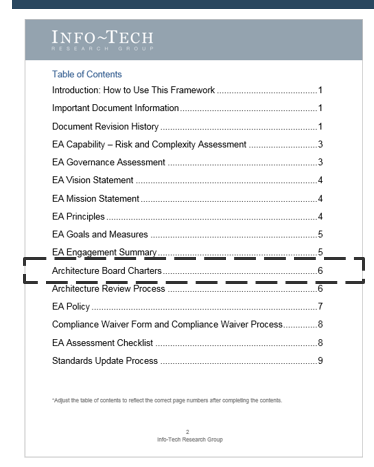
Step 1 Facilitate
Hold a working session with the stakeholders to define the charter for each of the identified architecture boards.
Download Architecture Board Charter Template
Step 2 Summarize
- Summarize the objectives of each board and reference the charter document within the EA Governance Framework.
- Upload the final charter document to the team’s common repository.
Update the EA Governance Framework document
Considerations when creating an architecture review process
- Ensure that architecture review happens at major milestones within the organization’s IT Operating Model such as the plan, build, and run phases.
- In order to provide continuous engagement, make the EA group accountable for solution architecture in the plan phase. In the build phase, the EA group will be consulted while the solution architect will be responsible for the project solution architecture.
Plan
- Strategy Development
- Business Planning
- A - Conceptualization
- Portfolio Management
Build
- Requirements
- R - Solution Design
- Application Development/ Procurement
- Quality Assurance
Run
- Deploy
- Operate
Best-practice project architecture review process
The best-practice model presented facilitates the creation of sound solution architecture through continuous engagement with the EA team and well-defined governance checkpoints.
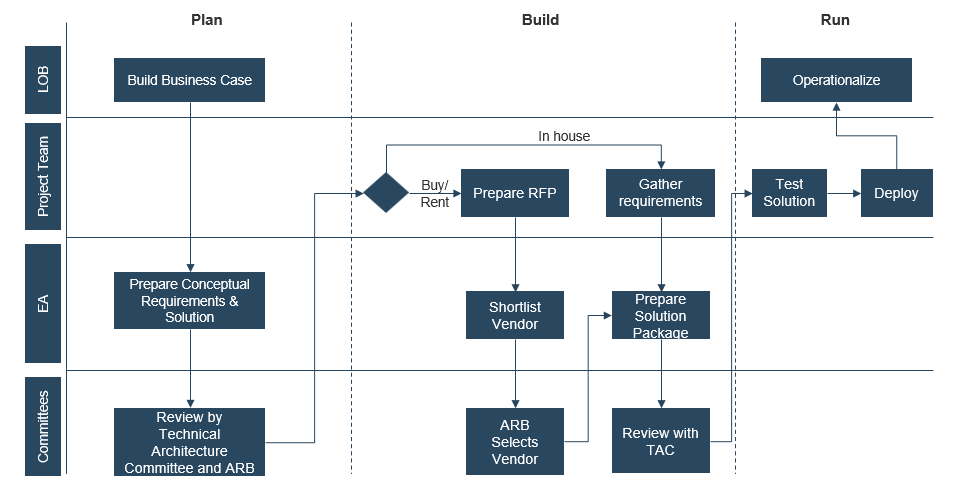
Develop the architecture review process
4.3 2 hours
Input
- A list of all EA governing bodies.
- Info-Tech’s best practice architecture review process.
Output
- The new architecture review process.
Materials
- A computer, and/or a whiteboard and marker.
Participants
- EA team, business line leads, IT department leads.
Hold a working session with the participants to develop the architecture review process. Facilitate the activity using the following steps:
- Reference Info-Tech’s best-practice architecture review process embedded within the “Architecture Review Process Template” to gain an understanding of an ideal architecture review process.
- Identify the stages within the plan, build, and run phases where solution architecture reviews should occur, and identify the governing bodies involved in these reviews.
- As you go through these stages, record your findings in the Architecture Review Process Template.
- Connect the various activities leading to and from the architecture creation points to outline the review process.
Download the Architecture Review Process Template for additional guidance regarding developing an architecture review process.
Develop the architecture review process
4.3 2 hrs
Input
- A list of all identified EA governing bodies.
Output
- Charters for each EA governing bodies.
Materials
- A computer, and/or a whiteboard and marker.
Participants
- EA team, business line leads, IT department leads.
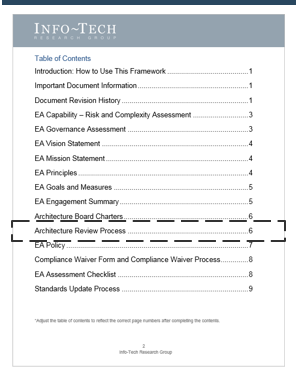
Step 1 - Facilitate
Download Architecture Review Process Template and facilitate a session to customize the best-practice model presented in the template.
Download the Architecture Review Process Template
Step 2 - Summarize
Summarize the process changes and document the process flow in the EA Governance Framework document.
Update the EA Governance Framework Template
Right-size EA governing bodies to reduce the perception of red tape
Case Study
Industry Insurance
Source Info-Tech
Situation
At INSPRO01, architecture governance boards were a bottleneck. The boards fielded all project requests, ranging from simple screen label changes to complex initiatives spanning multiple applications.
These boards were designed as forums for technology discussions without any business stakeholder involvement.
Complication
INSPRO01’s management never gave buy-in to the architecture governance boards since their value was uncertain.
Additionally, architectural reviews were perceived as an item to be checked off rather than a forum for getting feedback.
Architectural exceptions were not being followed through due to the lack of a dispensation process.
Result
Info-Tech has helped the team define adaptable inclusion/exclusion criteria (based on project complexity) for each of the architectural governing boards.
The EA team was able to make the case for business participation in the architecture forums to better align business and technology investment.
An architecture dispensation process was created and operationalized. As a result architecture reviews became more transparent with well-defined next steps.
If you want additional support, have our analysts guide you through this phase as part of an Info-Tech workshop
Book a workshop with our Info-Tech analysts:
- To accelerate this project, engage your IT team in an Info-Tech workshop with an Info-Tech analyst team.
- Info-Tech analysts will join you and your team onsite at your location or welcome you to Info-Tech’s historic Toronto office to participate in an innovative onsite workshop.
- Contact your account manager (www.infotech.com/account), or email Workshops@InfoTech.com for more information.
The following are sample activities that will be conducted by Info-Tech analysts with your team:
Key Activities
- Identify the number of governing bodies.
- Define the game plan to initialize the governing bodies.
- Define the architecture review process.
Outcomes
- Charter definition for each EA governance board
Phase 5
EA Policy
Create a Right-Sized Enterprise Architecture Governance Framework
EA Policy
- Current state of EA governance
- EA fundamentals
- Engagement model
- EA governing bodies
- EA policy
- Architectural standards
- Communication Plan
This phase will walk you through the following activities:
- Define the EA policy scope
- Identify the target audience
- Determine the inclusion and exclusion criteria
- Create an assessment checklist
This step involves the following participants:
- CIO
- IT Leaders
- Business Leaders
- Head of Enterprise Architecture
- Enterprise Architects
- Domain Architects
- Solution Architects
Outcomes of this step
- The completed EA policy
- Project assessment checklist
- Defined assessment outcomes
- Completed compliance waiver process
Info-Tech Insight
Use the EA policy to promote EA’s commitment to deliver value to business stakeholders through process transparency, stakeholder engagement, and compliance.
Phase 5 guided implementation
Call 1-888-670-8889 or email GuidedImplementations@InfoTech.com for more information.
Complete these steps on your own, or call us to complete a guided implementation. A guided implementation is a series of 2-3 advisory calls that help you execute each phase of a project. They are included in most advisory memberships.
Guided Implementation 5: EA Policy
Proposed Time to Completion: 3 weeks
Step 5.1–5.3: EA Policy, Assessment Checklists, and Decision Types
Start with an analyst kick-off call:
- Discuss the three pillars of EA policy and its purpose.
- Review the components of an effective EA policy.
- Understand how to develop architecture assessment checklists.
- Understand the assessment decision types.
Then complete these activities…
- Define purpose, scope, and audience of the EA policy.
- Create a project assessment checklist.
- Define the organization’s assessment decision type.
With these tools & templates:
- EA Policy Template
- EA Assessment Checklist Template
Step 5.4: Compliance Waivers
Review findings with analyst:
- Review your draft EA policy and gather feedback.
- Review your project assessment checklists and the assessment decision types.
- Discuss the best-practice architecture compliance waiver process and how to tailor it to your organizational needs.
Then complete these activities…
- Refine the EA policy based on feedback gathered.
- Create the compliance waiver process.
With these tools & templates:
- EA Compliance Waiver Process Template
- EA Compliance Waiver Form Template
Three pillars of architecture policy
Architecture policy is a set of guidelines, formulated and enforced by the governing bodies of an organization, to guide and constrain architectural choices in pursuit of strategic goals.
Architecture compliance – promotes compliance to organizational standards through well-defined assessment checklists across architectural domains.
Business value – ensures that investments are tied to business value by enforcing traceability to business capabilities.
Architectural guidance – provides guidance to architecture practitioners on the application of the business and technology standards.
Components of EA policy
An enterprise architecture policy is an actionable document that can be applied to projects of varying complexity across the organization.
- Purpose and Scope: This EA policy document clearly defines the scope and the objectives of architecture reviews within an organization.
- Target Audience: The intended audience of the policy such as employees and partners.
- Architecture Assessment Checklist: A wide range of typical questions that may be used in conducting Architecture Compliance reviews, relating to various aspects of the architecture.
- Assessment Outcomes: The outcome of the architecture review process that determines the conformance of a project solution to the enterprise architecture standards.
- Compliance Waiver: Used when a solution or segment architecture is perceived to be non-compliant with the enterprise architecture.
Draft the purpose and scope of the EA policy
5.1 2.5 hrs
Input
- A consensus on the purpose, scope, and audience for the EA policy.
Output
- Documented version of the purpose, scope, and audience for the EA policy.
Materials
- A computer, and/or a whiteboard and marker.
Participants
- EA team, CIO, business line leads, IT department leads.
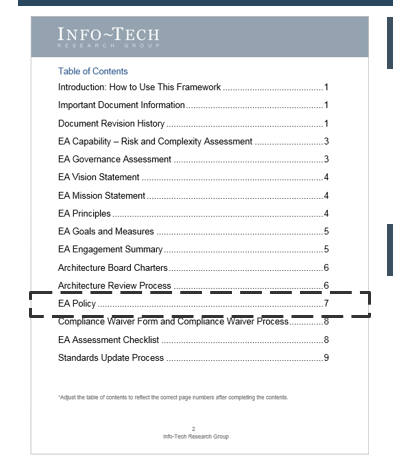
Step 1 - Facilitate
Download the EA Policy Template and hold a working session to draft the EA policy.
Download the EA Policy Template
Step 2 - Summarize
- Summarize purpose, scope, and intended audience of the policy in the EA Governance Framework document.
- Update the EA policy document with the purpose, scope and intended audience.
Update the EA Governance Framework Template
Architecture assessment checklist
Architecture assessment checklist is a list of future-looking criteria that a project will be assessed against. It provides a set of standards against which projects can be assessed in order to render a decision on whether or not the project can be greenlighted.
Architecture checklists should be created for each EA domain since each domain provides guidance on specific aspects of the project.
Sample Checklist Questions
Business Architecture:
- Is the project aligned to organizational strategic goals and objectives?
- What are the business capabilities that the project supports? Is it creating new capabilities or supporting an existing one?
Data Architecture:
- What processes are in place to support data referential integrity and/or normalization?
- What is the physical data model definition (derived from logical data models) used to design the database?
Application Architecture:
- Can this application be placed on an application server independent of all other applications? If not, explain the dependencies.
- Can additional parallel application servers be easily added? If so, what is the load balancing mechanism?
Infrastructure Architecture:
- Does the solution provide high-availability and fault-tolerance that can recover from events within a datacenter?
Security Architecture:
- Have you ensured that the corporate security policies and guidelines to which you are designing are the latest versions?
Create architectural assessment checklists
5.2 2 hrs
Input
- Reference architecture models.
Output
- Architecture assessment checklist.
Materials
- A computer, and/or a whiteboard and marker.
Participants
- EA team, business line leads, IT department leads.
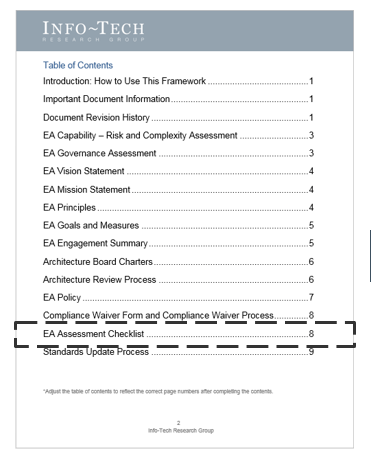
Step 1 - Facilitate
Download the EA Assessment Checklist Template and hold a working session to create the architectural assessment checklists.
Download the EA Assessment Checklist Template
Step 2 - Summarize
- Summarize the major points of the checklists in the EA Governance Framework document.
- Update the EA policy document with the detailed architecture assessment checklists.
Update the EA Governance Framework Template
Architecture assessment decision types
- As a part of the proposed solution review, the governing bodies produce a decision indicating the compliance of the solution architecture with the enterprise standards.
- Go, No Go, or Conditional are a sample set of decision outcomes available to the governing bodies.
- On a conditional approval, the project team must file for a compliance waiver.
Approved
- The solution demonstrates substantial compliance with standards.
- Negligible risk to the organization or minimal risks with sound plans of how to mitigate them.
- Architectural approval to proceed with delivery type of work.
Conditional Approval
- The significant aspects of the solution have been addressed in a satisfactory manner.
- Yet, there are some aspects of the solution that are not compliant with standards.
- The architectural approval is conditional upon presenting the missing evidence within a minimal period of time determined.
- The risk level may be acceptable to the organization from an overall IT governance perspective.
Not Approved
- The solution is not compliant with the standards.
- Scheduled for a follow-up review.
- Not recommended to proceed until the solution is more compliant with the standards.
Best-practice architecture compliance waiver process
Waivers are not permanent. Waiver terms must be documented for each waiver specifying:
- Time period after which the architecture in question will be compliant with the enterprise architecture.
- The modifications necessary to the enterprise architecture to accommodate the solution.
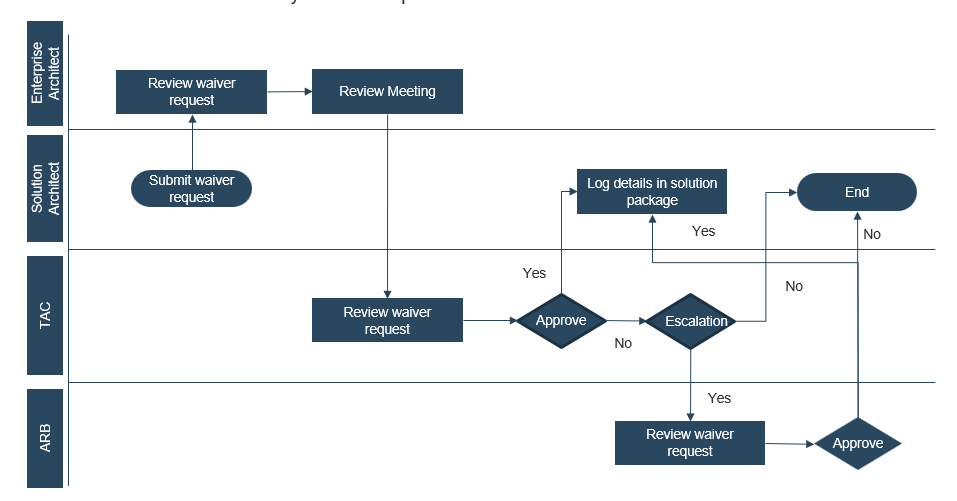
Create compliance waiver process
5.4 3-4 hrs
Input
- A consensus on the compliance waiver process.
Output
- Documented compliance waiver process and form.
Materials
- A computer, and/or a whiteboard and marker.
Participants
- EA team, business line leads, IT department leads.
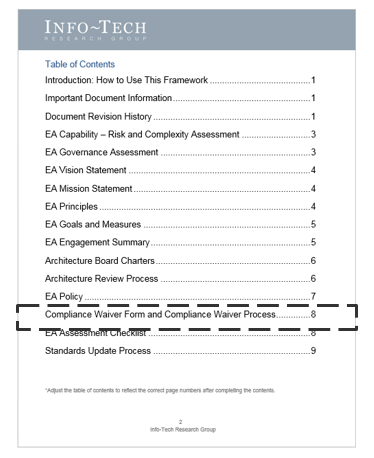
Step 1 - Facilitate
Download the EA compliance waiver template and hold a working session to customize the best-practice process to your organization’s needs.
Download the EA Compliance Waiver Process Template
Step 2 - Summarize
- Summarize the objectives and high-level process in the EA Governance Framework document.
- Update the EA policy document with the compliance waiver process.
- Upload the final policy document to the team’s common repository.
Update the EA Governance Framework Template
Creates an enterprise architecture policy to drive adoption
Case Study
Industry Insurance
Source Info-Tech
Situation
EA program adoption across INSPRO01 was at its lowest point due to a lack of transparency into the activities performed by the EA group.
Often, projects ignored EA entirely as it was viewed as a nebulous and non-value-added activity that produced no measurable results.
Complication
There was very little documented information about the architecture assessment process and the standards against which project solution architectures were evaluated.
Additionally, there were no well-defined outcomes for the assessment.
Project groups were left speculating about the next steps and with little guidance on what to do after completing an assessment.
Result
Info-Tech helped the EA team create an EA policy containing architecture significance criteria, assessment checklists, and reference to the architecture review process.
Additionally, the team also identified guidelines and detailed next steps for projects based on the outcome of the architecture assessment.
These actions brought clarity to EA processes and fostered better engagement with the EA group.
If you want additional support, have our analysts guide you through this phase as part of an Info-Tech workshop
Book a workshop with our Info-Tech analysts:
- To accelerate this project, engage your IT team in an Info-Tech workshop with an Info-Tech analyst team.
- Info-Tech analysts will join you and your team onsite at your location or welcome you to Info-Tech’s historic Toronto office to participate in an innovative onsite workshop.
- Contact your account manager (www.infotech.com/account), or email Workshops@InfoTech.com for more information.
The following are sample activities that will be conducted by Info-Tech analysts with your team:
Key Activities
- Define the scope.
- Identify the target audience.
- Determine the inclusion and exclusion criteria.
- Create an assessment checklist.
Outcomes
- The completed EA policy
- Project assessment checklist
- Defined assessment outcomes
- Completed compliance waiver process
Phase 6
Architectural Standards
Create a Right-Sized Enterprise Architecture Governance Framework
Architectural Standards
- Current state of EA governance
- EA fundamentals
- Engagement model
- EA governing bodies
- EA policy
- Architectural standards
- Communication Plan
This phase will walk you through the following activities:
- Identify and standardize EA work products
- Classify the architectural standards
- Identify the custodian of standards
- Update the standards
This step involves the following participants:
- Head of Enterprise Architecture
- Enterprise Architects
- Domain Architects
- Solution Architects
Outcomes of this step
- A standardized set of EA work products
- A way to categorize and store EA work products
- A defined method of updating standards
Info-Tech Insight
The architecture standard is the currency that facilitates information exchange between stakeholders. The primary purpose is to minimize transaction costs by providing a balance between stability and relevancy.
Phase 6 guided implementation
Call 1-888-670-8889 or email GuidedImplementations@InfoTech.com for more information.
Complete these steps on your own, or call us to complete a guided implementation. A guided implementation is a series of 2-3 advisory calls that help you execute each phase of a project. They are included in most advisory memberships.
Guided Implementation 6: Architectural standards
Proposed Time to Completion: 4 weeks
Step 6.1: Understand Architectural Standards
Start with an analyst kick-off call:
- Discuss architectural standards.
- Know how to identify and define EA work products.
- Understand the standard content of work products.
Then complete these activities…
- Identify and standardize EA work products.
Step 6.2–6.3: EA Repository and Updating the Standards
Review with analyst:
- Review the standardized EA work products.
- Discuss the principles of EA repository.
- Discuss the Info-Tech best-practice model for updating architecture standards and how to tailor them to your organizational context.
Then complete these activities…
- Build a folder structure for storing EA work products.
- Use the Info-Tech best-practice architecture standards update process to develop your organization’s process for updating architecture standards.
With these tools & templates:
- Architecture Standards Update Process Template
Recommended list of EA work products to standardize
- EA work products listed below are typically produced as a part of the architecture lifecycle.
- To ensure consistent development of architecture, the work products need to be standardized.
- Consider standardizing both the naming conventions and the content of the work products.
- EA vision: A document containing the vision that provides the high-level aspiration of the capabilities and business value that EA will deliver.
- Statement of EA Work: The Statement of Architecture Work defines the scope and approach that will be used to complete an architecture project.
- Reference architectures: A reference architecture is a set of best-practice taxonomy that describes components and the conceptual structure of the model, as well as graphics, which provide a visual representation of the taxonomy to aid understanding. Reference architectures are created for each of the architecture domains.
- Solution proposal: The proposed project solution based on the EA guidelines and standards.
- Compliance assessment request: The document that contains the project solution architecture assessment details.
- Architecture change request: The request that initiates a change to architecture standards when existing standards can no longer meet the needs of the enterprise.
- Transition architecture: A transition architecture shows the enterprise at incremental states that reflect periods of transition that sit between the baseline and target architectures.
- Architectural roadmap: A roadmap that lists individual increments of change and lays them out on a timeline to show progression from the baseline architecture to the target architecture.
- EA compliance waiver request: A compliance waiver request that must be made when a solution or segment architecture is perceived to be non-compliant with the enterprise architecture.
Standardize the content of each work product
- Purpose - The reason for the existence of the work product.
- Owner - The owner of this EA work product.
- Target Audience - The intended audience of the work product such as employees and partners.
- Naming Pattern - The pattern for the name of the work product as well as its file name.
- Table of Contents - The various sections of the work product.
- Review & Sign-Off Authority - The stakeholders who will review the work product and approve it.
- Repository Folder Location - The location where the work product will be stored.
Identify and standardize work products
6.1 3 hrs
Input
- List of various documents being produced by projects currently.
Output
- Standardized list of work products.
Materials
- A computer, and/or a whiteboard and marker.
Participants
- A computer, and/or a whiteboard and marker.
Instructions:
Hold a working session with the participants to identify and standardize work products. Facilitate the activity using the steps below.
- Identifying EA work products:
- Start by reviewing the list of all architecture-related documents presently produced in the organization. Any such deliverable with the following characteristics can be standardized:
- If it can be broken out and made into a standalone document.
- If it can be made into a fill-in form completed by others.
- If it is repetitive and requires iterative changes.
- Create a list of work products that your organization would like to standardize based on the characteristics above.
- Start by reviewing the list of all architecture-related documents presently produced in the organization. Any such deliverable with the following characteristics can be standardized:
- The content and format of standardized EA work products:
- For each work product your organization wishes to standardize, look at its purpose and brainstorm the content needed to fulfill that purpose.
- After identifying the elements that need to be included in the work product to fulfill its purpose, order them logically for presentation purposes.
- In each section of the work product that need to be completed, include instructions on how to complete the section.
- Review the seven elements presented in the previous slide and include them in the work products.
EA repository - information taxonomy
As the EA function begins to grow and accumulates EA work products, having a well-designed folder structure helps you find the necessary information efficiently.
Architecture meta-model
Describes the organizationally tailored architecture framework.
Architecture capability
Defines the parameters, structures, and processes that support the enterprise architecture group.
Architecture landscape
An architectural presentation of assets in use by the enterprise at particular points in time.
Standards information base
Captures the standards with which new architectures and deployed services must comply.
Reference library
Provides guidelines, templates, patterns, and other forms of reference material to accelerate the creation of new architectures for the enterprise.
Governance log
Provides a record of governance activity across the enterprise.
Create repository folder structure
6.2 5-6 hrs
Input
- List of standardized work products.
Output
- EA work products mapped to a repository folder.
Materials
- A computer, and/or a whiteboard and marker.
Participants
- EA team, IT department leads.
Instructions:
Hold a working session with the participants to create a repository structure. Facilitate the activity using the steps below:
- Start with the taxonomy on the previous slide, and sort the existing work products into these six categories.
- Assess that the work products are sorted in a mutually exclusive and collectively exhaustive fashion. This means that a certain work product that appears in one category should not appear in another category. As well, make sure these six categories capture all the existing work products.
- Based on the categorization of the work products, build a folder structure that follows these categories, which will allow for the work products to be accessed quickly and easily.
Create a process to update EA work products
- Architectural standards are not set in stone and should be reviewed and updated periodically.
- The Architecture Review Board is the custodian for standards.
- Any change to the standards need to be assessed thoroughly and must be communicated to all the impacted stakeholders.
Architectural standards update process
Identify
- Identify changes to the standards
Assess
- Review and assess the impacts of the change
Document
- Document the change and update the standard
Approve
- Distribute the updated standards to key stakeholders for approval
Communicate
- Communicate the approved changes to impacted stakeholders
Create a process to continually update standards
6.3 1.5 hrs
Input
- The list of work products and its owners.
Output
- A documented work product update process.
Materials
- A computer, and/or a whiteboard and marker.
Participants
- EA team, business line leads, IT department leads.
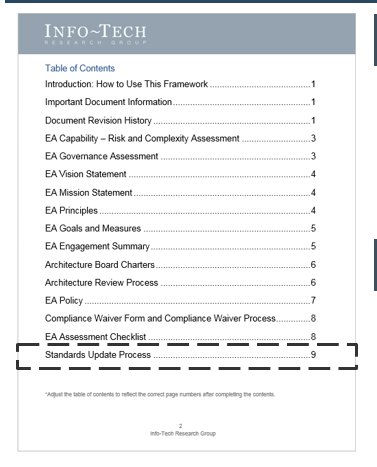
Step 1 - Facilitate
Download the standards update process template and hold a working session to customize the best practice process to your organization’s needs.
Download the Architecture Standards Update Process Template
Step 2 - Summarize
Summarize the objectives and the process flow in the EA governance framework document.
Update the EA Governance Framework Template
Create architectural standards to minimize transaction costs
Case Study
Industry Insurance
Source Info-Tech
Situation
INSPRO01 didn’t maintain any centralized standards and each project had its own solution/design work products based on the preference of the architect on the project. This led to multiple standards across the organization.
Lack of consistency in architectural deliverables made the information hand-offs expensive.
Complication
INSPRO01 didn’t maintain the architectural documents in a central repository and the information was scattered across multiple project folders.
This caused key stakeholders to make decisions based on incomplete information and resulted in constant revisions as new information became available.
Result
Info-Tech recommended that the EA team identify and standardize the various EA work products so that information was collected in a consistent manner across the organization.
The team also recommended an information taxonomy to store the architectural deliverables and other collateral.
This resulted in increased consistency and standardization leading to efficiency gains.
If you want additional support, have our analysts guide you through this phase as part of an Info-Tech workshop
Book a workshop with our Info-Tech analysts:
- To accelerate this project, engage your IT team in an Info-Tech workshop with an Info-Tech analyst team.
- Info-Tech analysts will join you and your team onsite at your location or welcome you to Info-Tech’s historic Toronto office to participate in an innovative onsite workshop.
- Contact your account manager (www.infotech.com/account), or email Workshops@InfoTech.com for more information.
The following are sample activities that will be conducted by Info-Tech analysts with your team:
Key Activities
- Identify and standardize EA work products.
- Classify the architectural standards.
- Identify the custodian of standards.
- Update the standards.
Outcomes
- A standardized set of EA work products
- A way to categorize and store EA work products
- A defined method of updating standards
Phase 7
Communication Plan
Create a Right-Sized Enterprise Architecture Governance Framework
Communication Plan
- Current state of EA governance
- EA fundamentals
- Engagement model
- EA governing bodies
- EA policy
- Architectural standards
- Communication Plan
This phase will walk you through the following activities:
- List the changes identified in the EA governance initiative
- Identify stakeholders
- Create a communication plan
This step involves the following participants:
- Head of Enterprise Architecture
- Enterprise Architects
- Domain Architects
- Solution Architects
Outcomes of this step
- Communication Plan
- EA Governance Framework
Info-Tech Insight
By failing to prepare, you are preparing to fail – maximize the likelihood of success for EA governance by engaging the relevant stakeholders and communicating the changes.
Phase 7 guided implementation
Call 1-888-670-8889 or email GuidedImplementations@InfoTech.com for more information.
Complete these steps on your own, or call us to complete a guided implementation. A guided implementation is a series of 2-3 advisory calls that help you execute each phase of a project. They are included in most advisory memberships.
Guided Implementation 6: Operationalize the EA governance framework
Proposed Time to Completion: 1 week
Step 7.1: Create a Communication Plan
Start with an analyst kick-off call:
- Discuss how to communicate changes to stakeholders.
- Discuss the purposes and benefits of the EA governance framework.
Then complete these activities…
- Identify the stakeholders affected by the EA governance transformations.
- List the benefits of the proposed EA governance initiative.
- Create a plan to communicate the changes to impacted stakeholders.
With these tools & templates:
- EA Governance Communication Plan Template
- EA Governance Framework Template
Step 7.2: Review the Communication Plan
Start with an analyst kick-off call:
- Review the communication plan and gather feedback on the proposed stakeholders.
- Confer about the various methods of communicating change in an organization.
- Discuss the uses of the EA Governance Framework.
Then complete these activities…
- Refine your communication plan and use it to engage with stakeholders to better serve customers.
- Create the EA Governance Framework to accompany the communication plan in engaging stakeholders to better understand the value of EA.
With these tools & templates:
- EA Governance Communication Plan Template
- EA Governance Framework Template
Communicate changes to stakeholders
The changes made to the EA governance components need to be reviewed, approved, and communicated to all of the impacted stakeholders.
Deliverables to be reviewed:
- Fundamentals
- Vision and Mission
- Goals and Measures
- Principles
- Architecture review process
- Assessment checklists
- Policy Governing body charters
- Architectural standards
Deliverable Review Process:
Step 1: Hold a meeting with stakeholders to review, refine, and agree on the changes.
Step 2: Obtain an official approval from the stakeholders.
Step 3: Communicate the changes to the impacted stakeholders.
Communicate the changes by creating an EA governance framework and communication plan
7.1 3 hrs
Input
- EA governance deliverables.
Output
- EA Governance Framework
- Communication Plan.
Materials
- A computer, and/or a whiteboard and marker.
Participants
- EA team, CIO, business line leads, IT department leads.
Instructions:
Hold a working session with the participants to create the EA governance framework as well as the communication plan. Facilitate the activity using the steps below:
- EA Governance Framework:
- The EA Governance Framework is a document that will help reference and cite all the materials created from this blueprint. Follow the instructions on the framework to complete.
- Communication Plan:
- Identify the stakeholders based on the EA governance deliverables.
- For each stakeholder identified, complete the “Communication Matrix” section in the EA Governance Communication Plan Template. Fill out the section based on the instructions in the template.
- As the stakeholders are identified based on the “Communication Matrix,” use the EA Governance Framework document to communicate the changes.
Download the EA Governance Communication Plan Template and EA Governance Framework Template for additional instructions and to document your activities in this phase.
Maximize the likelihood of success by communicating changes
Case Study
Industry Insurance
Source Info-Tech
Situation
The EA group followed Info-Tech’s methodology to assess the current state and has identified areas for improvement.
Best practices were adopted to fill the gaps identified.
The team planned to communicate the changes to the technology leadership team and get approvals.
As the EA team tried to roll out changes, they encountered resistance from various IT teams.
Complication
The team was not sure of how to communicate the changes to the business stakeholders.
Result
Info-Tech has helped the team conduct a thorough stakeholder analysis to identify all the stakeholders who would be impacted by the changes to the architecture governance framework.
A comprehensive communication plan was developed that leveraged traditional email blasts, town hall meetings, and non-traditional methods such as team blogs.
The team executed the communication plan and was able to manage the change effectively.
If you want additional support, have our analysts guide you through this phase as part of an Info-Tech workshop
Book a workshop with our Info-Tech analysts:
- To accelerate this project, engage your IT team in an Info-Tech workshop with an Info-Tech analyst team.
- Info-Tech analysts will join you and your team onsite at your location or welcome you to Info-Tech’s historic Toronto office to participate in an innovative onsite workshop.
- Contact your account manager (www.infotech.com/account), or email Workshops@InfoTech.com for more information.
The following are sample activities that will be conducted by Info-Tech analysts with your team:
Key Activities
- List the changes identified in the EA governance initiative.
- Identify stakeholders.
- Create a communication plan.
- Compile the materials created in the blueprint to better communicate the value of EA governance.
Outcomes
- Communication plan
- EA governance framework
Bibliography
Government of British Columbia. “Architecture and Standards Review Board.” Government of British Columbia. 2015. Web. Jan 2016. < http://www.cio.gov.bc.ca/cio/standards/asrb.page >
Hopkins, Brian. “The Essential EA Toolkit Part 3 – An Architecture Governance Process.” Cio.com. Oct 2010. Web. April 2016. < http://www.cio.com/article/2372450/enterprise-architecture/the-essential-ea-toolkit-part-3---an-architecture-governance-process.html >
Kantor, Bill. “How to Design a Successful RACI Project Plan.” CIO.com. May 2012. Web. Jan 2016. < http://www.cio.com/article/2395825/project-management/how-to-design-a-successful-raci-project-plan.html >
Sapient. “MIT Enterprise Architecture Guide.” Sapient. Sep 2004. Web. Jan 2016. < http://web.mit.edu/itag/eag/FullEnterpriseArchitectureGuide0.1.pdf >
TOGAF. “Chapter 41: Architecture Repository.” The Open Group. 2011. Web. Jan 2016. < http://pubs.opengroup.org/architecture/togaf9-doc/arch/chap41.html >
TOGAF. “Chapter 48: Architecture Compliance.” The Open Group. 2011. Web. Jan 2016. < http://pubs.opengroup.org/architecture/togaf9-doc/arch/chap48.html >
TOGAF. “Version 9.1.” The Open Group. 2011. Web. Jan 2016. http://pubs.opengroup.org/architecture/togaf9-doc/arch/
United States Secret Service. “Enterprise Architecture Review Board.” United States Secret Service. Web. Jan 2016. < http://www.archives.gov/records-mgmt/toolkit/pdf/ID191.pdf >
Virginia Information Technologies Agency. “Enterprise Architecture Policy.” Commonwealth of Virginia. Jul 2006. Web. Jan 2016. < https://www.vita.virginia.gov/uploadedfiles/vita_main_public/library/eapolicy200-00.pdf >
Research contributors and experts
Alan Mitchell, Senior Manager, Global Cities Centre of Excellence, KPMG
Alan Mitchell has held numerous consulting positions before his role in Global Cities Centre of Excellence for KPMG. As a Consultant, he has had over 10 years of experience working with enterprise architecture related engagements. Further, he worked extensively with the public sector and prides himself on his knowledge of governance and how governance can generate value for an organization.
Ian Gilmour, Associate Partner, EA advisory services, KPMG
Ian Gilmour is the global lead for KPMG’s enterprise architecture method and Chief Architect for the KPMG Enterprise Reference Architecture for Health and Human Services. He has over 20 years of business design experience using enterprise architecture techniques. The key service areas that Ian focuses on are business architecture, IT-enabled business transformation, application portfolio rationalization, and the development of an enterprise architecture capability within client organizations.
Djamel Djemaoun Hamidson, Senior Enterprise Architect, CBC/Radio-Canada
Djamel Djemaoun is the Senior Enterprise Architect for CBC/Radio-Canada. He has over 15 years of Enterprise Architecture experience. Djamel’s areas of special include service-oriented architecture, enterprise architecture integration, business process management, business analytics, data modeling and analysis, and security and risk management.
Sterling Bjorndahl, Director of Operations, eHealth Saskatchewan
Sterling Bjorndahl is now the Action CIO for the Sun Country Regional Health Authority, and also assisting eHealth Saskatchewan grow its customer relationship management program. Sterling’s areas of expertise include IT strategy, enterprise architecture, ITIL, and business process management. He serves as the Chair on the Board of Directors for Gardiner Park Child Care.
Huw Morgan, IT Research Executive, Enterprise Architect
Huw Morgan has 10+ years experience as a Vice President or Chief Technology Officer in Canadian internet companies. As well, he possesses 20+ years experience in general IT management. Huw’s areas of expertise include enterprise architecture, integration, e-commerce, and business intelligence.
Serge Parisien, Manager, Enterprise Architecture at Canada Mortgage Housing Corporation
Serge Parisien is a seasoned IT leader with over 25 years of experience in the field of information technology governance and systems development in both the private and public sectors. His areas of expertise include enterprise architecture, strategy, and project management.
Alex Coleman, Chief Information Officer at Saskatchewan Workers’ Compensation Board
Alex Coleman is a strategic, innovative, and results-driven business leader with a proven track record of 20+ years’ experience planning, developing, and implementing global business and technology solutions across multiple industries in the private, public, and not-for-profit sectors. Alex’s expertise includes program management, integration, and project management.
L.C. (Skip) Lumley , Student of Enterprise and Business Architecture
Skip Lumley was formerly a Senior Principle at KPMG Canada. He is now post-career and spends his time helping move enterprise business architecture practices forward. His areas of expertise include enterprise architecture program implementation and public sector enterprise architecture business development.
Additional contributors
- Tim Gangwish, Enterprise Architect at Elavon
- Darryl Garmon, Senior Vice President at Elavon
- Steve Ranaghan, EMEIA business engagement at Fujitsu